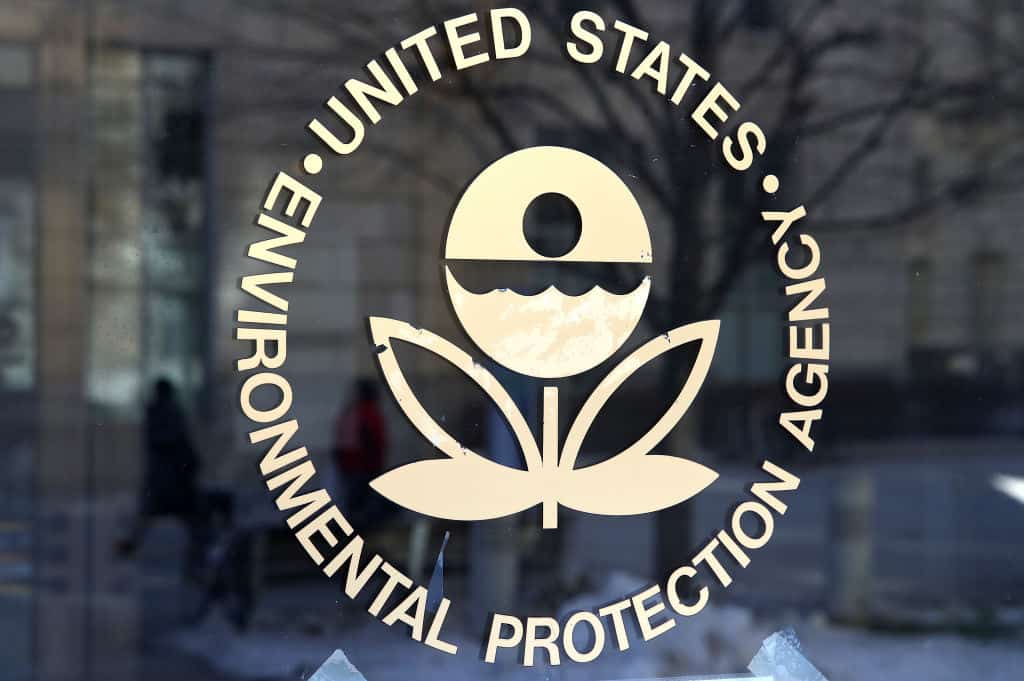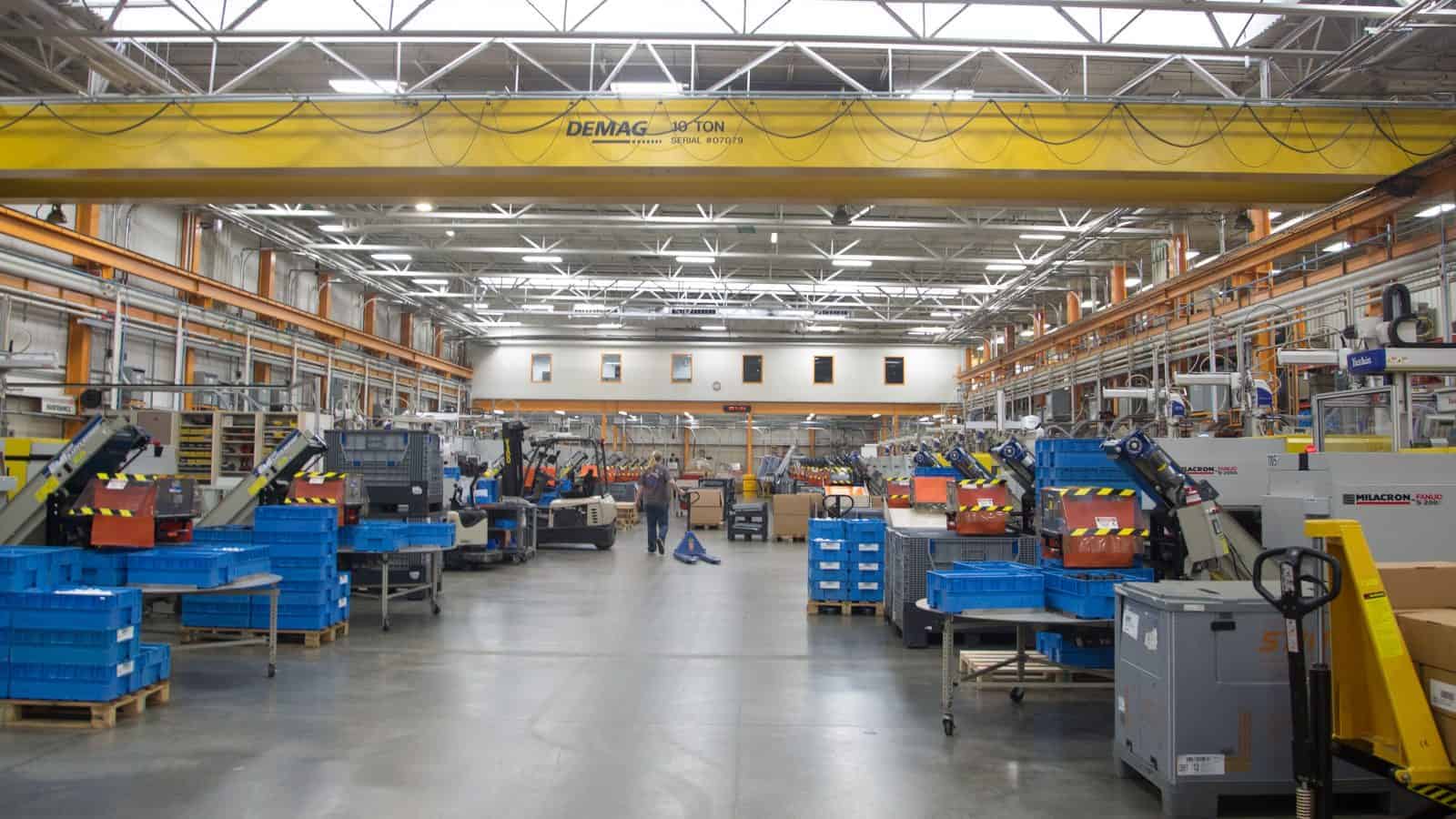Energy Permitting Reform Act Will Help Unlock the Full Potential of Manufacturing Industry, Is Critical for Competing with China

Washington, D.C. – Following the bipartisan passage of the Energy Permitting Reform Act of 2024 markup in the Senate Energy and Natural Resources Committee, National Association of Manufacturers President and CEO Jay Timmons released the following statement:
“Manufacturers have been calling attention to the consequences of America’s broken permitting process for years, while building a case for reform. Both sides of the aisle now realize that these critical updates will enable Congress to achieve its broader energy goals and the development of:
- Renewable energy projects;
- Pipelines for traditional energy, hydrogen and carbon capture storage;
- Critical mineral mines and processing facilities;
- Semiconductor and battery manufacturing fabs;
- Interstate transmission lines; and
- Hydroelectric and nuclear power plants.
“These developments are absolutely critical for us to be able to compete with China. As this legislation progresses, many of the commonsense policies outlined in the Energy Permitting Reform Act will help unlock the full potential of our industry, bolster our nation’s energy security and create American jobs. Streamlining permitting processes, cutting red tape, requiring that federal agencies make timely decisions and reducing the potential for baseless litigation will help prevent years-long delays for manufacturers—delays that give other countries a distinct advantage and put our own security at risk. America should never be content with a system that can take 10 or 15 years to approve urgently needed projects, when approval can take a fifth of that time in other countries that still adhere to high standards.
“We thank Chairman Manchin and Ranking Member Barrasso for introducing this legislation and look forward to working with lawmakers to advance it.”
-NAM-
The National Association of Manufacturers is the largest manufacturing association in the United States, representing small and large manufacturers in every industrial sector and in all 50 states. Manufacturing employs nearly 13 million men and women, contributes $2.89 trillion to the U.S. economy annually and accounts for 53% of private-sector research and development. The NAM is the powerful voice of the manufacturing community and the leading advocate for a policy agenda that helps manufacturers compete in the global economy and create jobs across the United States. For more information about the NAM or to follow us on Twitter and Facebook, please visit www.nam.org.
NAM Calls for Oversight on the CPSC

Manufacturers have long been partners of the Consumer Product Safety Commission—working with the agency to keep the public informed and protected—but a lack of transparency at the CPSC in the past few years has stymied businesses’ attempts “to understand how [they] will be regulated,” the NAM told the House Energy and Commerce Subcommittee on Innovation, Data and Commerce ahead of a hearing Tuesday.
What’s going on: The NAM has regularly called for congressional oversight of the CPSC in recent years. Ahead of the “Fiscal Year 2025 Consumer Product Safety Commission Budget” subcommittee hearing, the NAM highlighted several areas of concern for legislators to address:
- Section 6(b) of the Consumer Product Safety Act: “Manufacturers strongly support maintaining the crucial, balanced and effective information disclosure procedures currently mandated in the Consumer Product Safety Act,” said NAM Vice President of Domestic Policy Charles Crain. “Unfortunately, in recent years, the CPSC has attempted to circumvent these standards, releasing statements that lack any scientific data or research or by taking actions without official agency rulemaking.”
- Effective communication of rulemaking and research with regulated businesses: Despite a CPSA requirement that the agency defer to voluntary standards in certain safety-measure compliance cases, “there are recent examples of the agency commencing a proposed rulemaking in an apparent rush to regulate.” The agency has also begun unnecessarily withholding from manufacturers the test reports and analysis they need to create voluntary standards, while giving manufacturers “reduced time … to implement proposed and final rules.”
- Public engagement by CPSC commissioners and staff: “One of the benefits of a small federal agency with multiple commissioners is the availability of commissioners and senior staff to meet with interested parties on relevant topics,” Crain continued. “Unfortunately, in recent years, the CPSC has been less willing to engage in productive conversations with regulated entities.”
The last word: “It is critical that the CPSC effectively communicate and work with manufacturers to ensure that our shared goal of consumer safety is maintained,” said Crain. “The NAM will continue engaging with both the CPSC and Congress to see that the agency is effectively engaging with the manufacturing community.”
NAM Legal Center Talks Chevron

The Supreme Court’s ruling in the closely watched Loper Bright Enterprises v. Raimondo is a watershed decision for administrative law with significant implications for the business community. The NAM Legal Center provided us with an overview.
What’s going on: Late last month, the Supreme Court overturned the “Chevron doctrine,” which since 1984 had required federal courts to defer to an administrative agency’s interpretation of an ambiguous statute—so long as the interpretation was reasonable.
What it means: The end of the doctrine means less power for federal agencies, potentially fewer regulations and a guaranteed surge in regulatory litigation, according to the Legal Center.
- When Congress leaves ambiguities or gaps in statutes, agencies can no longer exploit those gaps to enact overreaching rules or regulations (read the NAM’s statement on the decision here).
- Although Chevron had not been cited by the Supreme Court since 2016, it is the basis for 70 Supreme Court opinions and approximately 17,000 lower court decisions. Those holdings remain intact for now but could be challenged anew by litigants under the new standard.
The majority opinion: Writing for the majority, Chief Justice John Roberts relied on a plain-text reading of the Administrative Procedure Act, which directs courts—not agencies—“to decide all questions of law.”
- “The APA, in short, incorporates the traditional understanding of the judicial function, under which courts must exercise independent judgment in determining the meaning of statutory provisions,” he wrote.
- Absent an explicit delegation by Congress, agency interpretations can guide or inform courts, but in keeping with the APA, they cannot be given binding deference. According to the court, all statutes “have a single, best meaning,” and “courts use every tool at their disposal to determine the best reading of the statute and resolve the ambiguity.”
The dissent: Writing for the liberal justices in dissent, Justice Elena Kagan expressed concerns with overturning this “cornerstone” of regulatory law by shifting interpretative authority from “expert, experienced and politically accountable agenc[ies]” to courts that have “no special competence.”
In sum: The decision will result in a broad reduction in the power of executive branch agencies, with that power shifting to federal courts.
- Thus, regardless of the party in power or its pro- or anti-regulatory leaning, much less regulatory discretion will be afforded to the agencies.
The NAM predicts: Looking forward, the NAM sees Congress and regulators turning to industry for input as policies are adopted and statutes are interpreted, giving manufacturers an opportunity to play a more significant role in shaping outcomes.
What we’re doing: The NAM Legal Center is currently leading regulatory challenges against the Environmental Protection Agency, the Occupational Safety and Health Administration and the Securities and Exchange Commission. It will continue to push back on overreaching agency actions that threaten manufacturing competitiveness—now on a more even playing field.
Supreme Court Decision is Game-Changing Transformation for Legal and Regulatory Landscape for Manufacturers
Washington, D.C. – Today, the United States Supreme Court overruled the Chevron doctrine—a requirement that federal courts defer to an administrative agency’s interpretation of an ambiguous statute—that had proven unworkable and incoherent.
“The legal and regulatory landscape has transformed in the blink of an eye. Manufacturers will not waste a moment in seizing this opportunity—an opportunity that we have never seen before—to leverage this decision to rein in the regulations that are holding back manufacturers from improving lives,” said National Association of Manufacturers President and CEO Jay Timmons. “The NAM Legal Center and our best-in-class advocacy team will be on the field, leveraging this decision and the new tools it gives us, to fight back new regulations we are facing today as well as whatever may come our way in the next administration. For anyone who wants to see manufacturing grow and succeed in America, today heralds the possibility for a much brighter future.”
“Today’s ruling is a game changer for manufacturers as Chevron was at least partly to blame for the unpredictability and overreach that have become synonymous with the modern regulatory state,” said NAM Chief Legal Officer Linda Kelly. “We are hopeful that this marks the end of an overbearing regulatory system that had become complex, and compliance in many cases that was contradictory from agency to agency. For the past 40 years, Chevron has tipped the scales in favor of unelected officials and against the regulated public. Now the onus is on Congress to provide clear guardrails and guidelines in its intent to ensure that laws are implemented in a manner that achieves their goal. Manufacturers are eager to work with lawmakers to develop policies that promote innovation, job creation, economic growth and improved quality of life for all Americans.”
“Manufacturers have been the subject of a regulatory onslaught, with agencies’ far-reaching decisions affecting companies of all sizes,” said NAM Managing Vice President of Policy Chris Netram. “The EPA, SEC and DOL—the aggressive nature of rulemaking and enforcement actions that exceed authority come from the alphabet soup of regulators. The NAM has been successful in fighting key rules in court, and today’s decision gives us the ability to challenge even more actions while ensuring future agency actions do not exceed the authority mandated by Congress.”
-NAM-
The National Association of Manufacturers is the largest manufacturing association in the United States, representing small and large manufacturers in every industrial sector and in all 50 states. Manufacturing employs nearly 13 million men and women, contributes $2.89 trillion to the U.S. economy annually and accounts for 53% of private-sector research and development. The NAM is the powerful voice of the manufacturing community and the leading advocate for a policy agenda that helps manufacturers compete in the global economy and create jobs across the United States. For more information about the NAM or to follow us on Twitter and Facebook, please visit www.nam.org.
Manufacturers Score Victory on Proxy Firms

The NAM achieved a significant victory in court Wednesday in a case that sought to bring needed oversight to proxy advisory firms—and, more broadly, to ensure regulatory certainty for manufacturers.
The background: Proxy firms make recommendations regarding the way shareholders should vote on proxy ballot proposals that come before public companies.
- These firms operate with minimal oversight despite their outsized influence and even though their decisions can have significant and sometimes harmful impacts.
The fight: In 2020, the Securities and Exchange Commission finalized an NAM-backed rule that included a range of modest but critical reforms to proxy firms’ business models.
- In particular, the 2020 rule ensured that companies had more information about the firms’ voting recommendations and provided investors with companies’ responses to those recommendations.
- But in 2022, the SEC rescinded critical portions of that rule.
- The NAM sued the SEC, asking the U.S. Court of Appeals for the Fifth Circuit to strike down this arbitrary and capricious agency action.
The victory: This week—in news covered by Reuters, POLITICO Pro (subscription), Law360 (subscription), Pensions & Investments (subscription) and Bloomberg (subscription)—the Fifth Circuit ruled in the NAM’s favor, deciding that the SEC acted unlawfully in rescinding the 2020 rule. In particular, the court made two critical points:
- The court held that the SEC’s stated justification for its decisions to rescind NAM-supported proxy firm reforms didn’t pass muster and called the agency’s reasoning “facially irrational” and not “reasonable [or] reasonably explained.”
- The court also ruled that a government agency reversing course despite no change in its underlying factual findings must “explain its about-face” by “giv[ing] a more detailed explanation” than the SEC provided.
- This ruling builds on existing case law that prevents agencies from arbitrarily reversing policies after administrations change, thus encouraging regulatory certainty for manufacturers.
Our take: “This decision confirms that federal agencies are bound by the rule of law, even as administrations change,” said NAM Chief Legal Officer Linda Kelly.
- “Manufacturers depend on the SEC to be a steady regulatory hand at the wheel of America’s world-leading capital markets—an obligation the agency abandoned in rescinding the commonsense, compromise 2020 proxy advisory firm rule. … We will continue to fight in court to uphold the 2020 rule—and to work with the SEC and with Congress to ensure appropriate oversight of these powerful actors.”
Manufacturers Victorious Over SEC in Fifth Circuit Proxy Firm Case
Decision confirms that federal agencies are bound by the rule of law, even as administrations change
Washington, D.C.–Yesterday, the U.S. Court of Appeals for the Fifth Circuit ruled in the National Association of Manufacturers’ favor in NAM v. SEC, overturning the Securities and Exchange Commission’s rescission of critical provisions of its 2020 proxy advisory firm rule. NAM Chief Legal Officer Linda Kelly released the following statement on the ruling:
“This decision confirms that federal agencies are bound by the rule of law, even as administrations change. Manufacturers depend on the SEC to be a steady regulatory hand at the wheel of America’s world-leading capital markets—an obligation the agency abandoned in rescinding the commonsense, compromise 2020 proxy advisory firm rule.
“The NAM Legal Center is proud to have secured this critical victory, which strikes down the SEC’s unlawful about-face and preserves important provisions from the 2020 rule designed to protect manufacturers and Main Street investors from proxy firms’ outsized influence. We will continue to fight in court to uphold the 2020 rule—and to work with the SEC and with Congress to ensure appropriate oversight of these powerful actors.”
Background:
- The NAM has long called for increased oversight of proxy advisory firms. In July 2020, the SEC issued final regulations to enhance transparency and accountability for proxy firms, a move NAM President Jay Timmons called a “long-sought, major win for the industry and millions of manufacturing workers.” In October 2020, the NAM filed a motion to intervene in ISS v. SEC (ISS’s attempt to overturn the rule) in support of these reforms—a case that is still ongoing in the U.S. Court of Appeals for the D.C. Circuit.
- In June 2021, the SEC announced that it was suspending enforcement of the 2020 rule; the NAM filed suit against the SEC in October 2021 challenging this unlawful suspension. The U.S. District Court for the Western District of Texas ruled in the NAM’s favor in that case, vacating the SEC’s suspension of the rule.
- In July 2022, the SEC rescinded critical portions of the 2020 rule, a move that Timmons said “epitomizes ‘arbitrary and capricious’ rulemaking”; the NAM later filed suit to challenge the rescission. The Fifth Circuit decision overturns the SEC’s 2022 rescission of important provisions that increased transparency into proxy firms’ recommendations.
-NAM-
The National Association of Manufacturers is the largest manufacturing association in the United States, representing small and large manufacturers in every industrial sector and in all 50 states. Manufacturing employs nearly 13 million men and women, contributes $2.89 trillion to the U.S. economy annually and accounts for 53% of private-sector research and development. The NAM is the powerful voice of the manufacturing community and the leading advocate for a policy agenda that helps manufacturers compete in the global economy and create jobs across the United States. For more information about the NAM or to follow us on Twitter and Facebook, please visit www.nam.org.
NYT Investigation: Pharmacy Benefit Managers Drive Up Costs for Employers

Although they were created to keep prescription drug prices down, pharmacy benefit managers “frequently do the opposite” (The New York Times, subscription)—and that’s one of the main reasons the NAM has long advocated for their reform.
What’s going on: “The job of the P.B.M.s is to reduce drug costs. Instead, they …
steer patients toward pricier drugs, charge steep markups on what would otherwise be inexpensive medicines and extract billions of dollars in hidden fees, a New York Times investigation found.”
Why it’s important: PBMs frequently charge employers and government programs, such as Medicare, many times the wholesale cost of a medication and keep the difference, according to the Times.
- And it’s not just those taking prescriptions who pay; when drug costs are inflated, everyone ends up paying higher insurance premiums.
- What’s more, “[b]ecause of recent mergers, [the big three PBMs] are becoming more dominant, collectively processing roughly 80 percent of prescriptions in the United States.” That’s up more than 30% from just 12 years ago.
Working around a workaround: In 2018, in response to growing pressure from employers to get PBMs to share more of the discounts from drug manufacturers, PBMs set up entities known as group purchasing organizations.
- These GPOs pass savings to employers—but they “also began imposing new fees on drug manufacturers,” money they were not contractually bound to pass on to clients.
- The result: “Employers are none the wiser. They receive rebates. But they can’t see the billions of dollars in fees that the G.P.O.s take for themselves.”
Congress makes moves: Since the beginning of last year, seven House and Senate committees have passed PBM-reform legislation, including policies to increase transparency into PBMs’ business practices, delink PBM compensation from medications’ list prices and ensure that rebates are fully passed through to the plan sponsor or patient.
- The NAM has been crucial in educating lawmakers on the need for these reforms and continues to advocate for PBM reform to be signed into law this year.
The last word: “PBMs drive up health care costs for manufacturers and manufacturing workers,” said NAM Vice President of Domestic Policy Charles Crain. “Congress must act as soon as possible to enact comprehensive PBM reform that benefits employers by making PBM contracts more straightforward, transparent and predictable—and benefits workers by reducing the prices they pay out of pocket for their prescriptions.”
NAM, ACC Challenge EPA’s National Drinking Water Rule

The NAM and the American Chemistry Council yesterday filed a petition challenging the Environmental Protection Agency’s first-ever national drinking water standard limiting the presence of six types of per- and polyfluoroalkyl substances, or PFAS.
What’s going on: The organizations are seeking to overturn the final rule—issued in April by the EPA—in the D.C. Circuit Court of Appeals on the grounds that it exceeds the agency’s authority under the Safe Drinking Water Act of 1974 and “is arbitrary, capricious and an abuse of discretion,” in violation of the Administrative Procedure Act.
- Under the rule, PFAS in municipal water systems are limited to near-zero levels. Systems nationwide will have three years to monitor for the chemicals and two subsequent years to install technology to reduce the compounds’ levels in the water.
- The water systems will (and, in fact, have already begun to) sue manufacturers to cover their costs. Meanwhile, plaintiffs’ attorneys are using the standard in product liability and greenwashing suits against manufacturers.
- PFAS are a diverse group of chemicals that have been used widely for decades due to their unique ability to douse fires and resist grease, stains and corrosion. Today they’re a key component in a wide range of critical products, from semiconductors, to the components of the electrical grid, to renewable-energy production equipment.
Why it’s problematic: The final regulation of PFAS “is wholly infeasible and threatens these vital substances’ continued application in manufacturing processes,” said NAM Chief Legal Officer Linda Kelly, adding that the agency’s rulemaking is based “on a deeply flawed cost-benefit analysis” and fails to follow Safe Drinking Water Act procedure and other statutory requirements.
- “In many instances, there is no viable alternative for these chemicals, and companies may be forced to change plans dramatically” to follow the new rule, NAM Managing Vice President of Policy Chris Netram said in April.
- “In everyday life, including emergency situations like a fire or operating room circumstance, there’s a real reliance on these products—it’s not just about job losses and costs but fundamental decisions that have widespread ramifications,” Netram added recently.
What should be done: The rule should be vacated as soon as possible, the NAM and the ACC told the court.
Manufacturers Challenge Infeasible, Costly Water Standard
The NAM Legal Center and ACC File Suit to Block the Rule
Washington, D.C. – Today, the National Association of Manufacturers, joined by the American Chemistry Council, filed a petition in the D.C. Circuit Court of Appeals challenging the Environmental Protection Agency’s final rule setting individual standards for six per- and polyfluoroalkyl substances, also known as PFAS, in municipal water systems.
“Manufacturers support commonsense regulations on PFAS that recognize the criticality of these substances across several industrial sectors—for many of these critical applications, there are no viable alternatives,” said NAM Chief Legal Officer Linda Kelly. “What the EPA did, however, was to bulldoze ahead with standards that set an acceptable level for PFAS at near zero—which is wholly infeasible and threatens these vital substances’ continued application in manufacturing processes. In doing so, the EPA relied on a deeply flawed cost-benefit analysis and failed to follow the clear-cut statutory procedures required by the Safe Drinking Water Act, among other substantive and procedural deficiencies. The NAM Legal Center is filing suit to overturn this unachievable standard and protect manufacturing operations and jobs across the country.”
PFAS are a diverse group of chemicals essential to modern life, including in the transformers used to power electric grids; in the semiconductors and solar components needed for clean energy transition; and in the aircraft, munitions, fire suppression systems and communication devices required for national security.
-NAM-
The National Association of Manufacturers is the largest manufacturing association in the United States, representing small and large manufacturers in every industrial sector and in all 50 states. Manufacturing employs nearly 13 million men and women, contributes $2.89 trillion to the U.S. economy annually and accounts for 53% of private-sector research and development. The NAM is the powerful voice of the manufacturing community and the leading advocate for a policy agenda that helps manufacturers compete in the global economy and create jobs across the United States. For more information about the NAM or to follow us on Twitter and Facebook, please visit www.nam.org.
NAM, Partners File Opening Brief in Suit Against EPA

On Thursday, the NAM, joined by other business groups, filed the opening brief in their pending lawsuit against the Environmental Protection Agency.
What’s going on: In March, the groups petitioned the D.C. Circuit to review the EPA’s reconsideration of the National Ambient Air Quality Standards for fine particulate matter (or PM2.5), which lowers the allowable level to 9 micrograms per cubic meter of air from 12, a 25% reduction. The agency handed down the final, tightened rule in February.
- In their brief, the coalition argues that the EPA lacks the authority under the Clean Air Act—the law that authorizes it to establish the NAAQS—to “reconsider” a decision made in 2020 to not lower the PM2.5 standard; that the agency failed to take into account the cost and feasibility of a tightened standard; and that it failed to give a “reasoned explanation for key aspects of its decision.”
- The groups participating in the suit with the NAM are the U.S. Chamber of Commerce, the American Chemistry Council, the American Petroleum Institute, the American Forest & Paper Association, the American Wood Council, the National Mining Association and the Portland Cement Association.
Why it’s important: The tighter NAAQS rule could result in many parts of the U.S. being designated as in nonattainment, which would trigger significant new costs for manufacturers and others attempting to obtain air permits in those locations.
- Many of these areas “are indisputably handicapped in their ability to reduce emissions to meet the new NAAQS” due to factors beyond municipalities’ and manufacturers’ control (i.e., wildfires, which affect most of the contiguous U.S. at some point each year).
- The new rule could also prevent manufacturers from building or modifying facilities in certain areas, undermining the Biden administration’s own “Investing in America” agenda, as it would stifle investment in manufacturing and kill—not create—well-paying manufacturing jobs.
What should be done: The rule should be vacated as soon as possible, the groups told the court.
